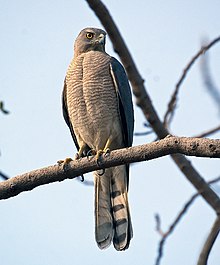Shikra
| Shikra | |
|---|---|
 |
|
| Adult female (dussumieri) | |
| Scientific classification | |
| Kingdom: | Animalia |
| Phylum: | Chordata |
| Class: | Aves |
| Order: | Accipitriformes |
| Family: | Accipitridae |
| Genus: | Accipiter |
| Species: | A. badius |
| Binomial name | |
|
Accipiter badius Gmelin, 1788 |
|
| Subspecies | |
| Synonyms | |
|
Astur badius |
|
Astur badius
Scelospizias badius
Micronisus badius
The shikra (Accipiter badius) is a small bird of prey in the family Accipitridae found widely distributed in Asia and Africa where it is also called the little banded goshawk. The African forms may represent a separate species but have usually been considered as subspecies of the shikra. The shikra is very similar in appearance to other sparrowhawk species including the Chinese goshawk and Eurasian sparrowhawk. They have a sharp two note call and have the typical flap and glide flight. Their calls are imitated by drongos and the common hawk-cuckoo resembles it in plumage.
The shikra is a small raptor (26–30 cm long) and like most other Accipiter hawks, this species has short rounded wings and a narrow and somewhat long tail. Adults are whitish on the underside with fine rufous bars while the upperparts are grey. The lower belly is less barred and the thighs are whitish. Males have a red iris while the females have a less red (yellowish orange) iris and brownish upperparts apart from heavier barring on the underparts. The females are slightly larger. The mesial stripe on the throat is dark but narrow. In flight the male seen from below shows a light wing lining (underwing coverts) and has blackish wing tips. When seen from above the tail bands are faintly marked on the lateral tail feathers and not as strongly marked as in the Eurasian sparrowhawk. The central tail feathers are unbanded and only have a dark terminal band. Juveniles have dark streaks and spots on the upper breast and the wing is narrowly barred while the tail has dark but narrow bands. A post juvenile transitional plumage is found with very strong barring on the contour feathers of the underside. The call is pee-wee, the first note being higher and the second being longer. In flight the calls are shorter and sharper kik-ki ... kik-ki. The Chinese sparrowhawk is somewhat similar in appearance but has swollen bright orange ceres and yellow legs with the wing tips entirely black.
Several subspecies are recognized across its range and some of them may be treated as full species. It has been suggested, based on differences in morphology and calls, that the African forms do not belong to this species. Subspecies cenchroides (Severtzov) is larger and paler and found in Turkestan, Afghanistan and eastern Iran. The Indian population dussumieri is resident on the plains and lower hills (up to 1400 m in the Himalayas). The nominate form is found in Sri Lanka and has somewhat darker grey upperparts. The Burmese shikra A. b. poliopsis may represent a distinct species. The population on Car Nicobar Island, earlier treated as a subspecies butleri and that on Katchall Island, obsoletus are now treated as a sub-species within a full species, the Nicobar sparrowhawk (Accipiter butleri). The west African population A. b. sphenurus is migratory while the southern African A. b. polyzonoides is more nomadic in its movements. In Asia only A. b. cenchroides is migratory.
...
Wikipedia

